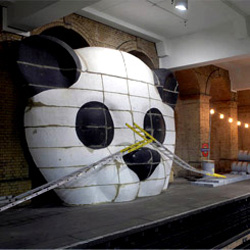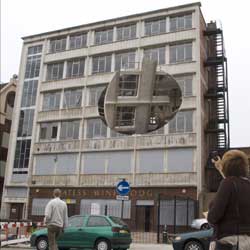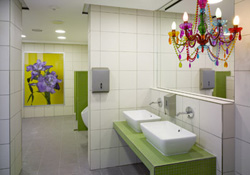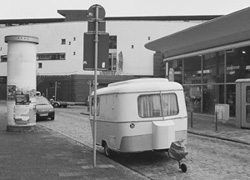Art in Public Contexts - the contemporary approach
The symposium, held on 27 November 2007 at the London Transport Museum in Covent Garden, was intended as an opportunity for the audience to hear about contemporary approaches to producing innovative works, whether temporary or permanent, in a range of contexts. Speakers had been invited on the basis of their experience and reputation for producing challenging works of art in demanding situations. The audience included artists, curators and property developers, as well as people who write about public art.
The event coincided with the re-launch of Platform for Art as Art on the Underground and the publication of a book about the programme.
Art on the Underground
Tamsin Dillon (TD), Head of Art on the Underground gave some background to the development of the Platform for Art programme. TD has produced over 40 projects on the Underground network since 2002 working with a range of high-calibre artists including Cindy Sherman, Beatriz Milhazes, Mark Titchner, Richard Wentworth and Liam Gillick. The programme has grown in scale and ambition and now includes large-scale work such as the recent installation by Brian Griffiths ‘Life is a Laugh’ at Gloucester Road underground station.

Brian Griffiths, 'Life is a Laugh'
July 2007 - May 2008
Gloucester Road Underground station, London
Context for the event
There has been a celebration of the centenary of the Piccadilly Line, community arts projects involving local residents and students as well as LU staff e.g. for the London Bridge artwork 'Journey to the Centre of the Earth' by Gayle Chong Kwan and stations that have been locations for art include Southwark, Arnos Grove and London Bridge.
To mark the programme’s re-launch as Art on the Underground, there is a publication, 'Platform for Art: Art on the Underground' and a giveaway of posters of artwork by five artists, including Mark Titchner. Future plans include a new focus on the whole network rather than on selected sites and permanent projects e.g. at Stratford station in the lead up to the 2012 Olympics.
Achim Borchardt-Hume (AB), Curator for Modern and Contemporary Art at Tate Modern, introduced the symposium speakers by reflecting on what makes public art ‘public’. He identified four overriding issues for those working in the field:
- The curator and agency – leading to the approach and position taken
- How public works are being critically reviewed / received and how this contrasts with gallery works
- Great claims are made for the impact of public art: how can its effectiveness be evaluated? How does this contrast with the original vision for the work?
- What are the socio-economic realities within which we operate?
Claire Doherty, SITUATIONS
Claire Doherty (CD), Curator / Writer who leads SITUATIONS in Bristol; a research and commissioning programme devised to investigate the significance of place and context in contemporary art.
CD felt that the event was a chance to evaluate our values, approach and achievements. We need to challenge our assumptions and examine existing definitions of public art. There have been significant shifts in commissioning public art, to commissioning for situations rather than sites. There has also been a proliferation of temporary projects, which have required new approaches.
What’s at stake? ‘Art in the public realm’ may be a more helpful term than ‘public art’.

Richard Wilson, 'Turning the Place Over' Liverpool, 2007-8
Developments in the 'public realm'
Claire Doherty gave a brief yet comprehensive survey of academic writing on public art and developments in the public realm, covering:
Habermas’s concept of the bourgeois public sphere as essentially masculine
Art can change how you see a place especially when it is encountered unexpectedly
- The role of public art in making the familiar strange e.g. Richard Wilson’s – ‘Turning the Place Over’ in Liverpool; Ivan and Heather Morrison’s ‘crashed’ lorry spilling flowers
- Miwon Kwon – One Place After Another: Site-Specific Art and Locational Identity
- Richard Serra: “to remove the work is to destroy the work” e.g. artwork is completely site-specific.
- Robert Smithson – Spiral Jetty, Utah and Great Salt Lake – sculpture on a massive scale.
- Francis Alys – When Faith Moves Mountains (2002) – visibility of participants and the work that went into making the artwork; the artist aimed to ‘de-romanticise’ land art
- Increasing internationalism – mobilisation of artists across the world
- Influence of the Situationists of the 1950s and 1960s – but the difference now is that most artists working in this way are commissioned rather than working independently / clandestinely
- Fictional walks by Janet Cardiff: exploring the urban environment
- The recent interest in the human scale and impact of artworks e.g. the RSA Arts & Ecology programme.
- How can we judge these artworks if ‘Everyone is an artist’? (Joseph Beuys)
- Kwon ‘art in the public interest’ is replacing art in public spaces – art as public space
- Compromising between the autonomy of the artist and social interventionism.
- Cultural tourism – is the place becoming more important than the art? e.g. Istanbul, Muenster
- Different models of commissioning e.g. ‘art as spectacle’: temporary projects that live on in memory even when the audience only gets a fleeting glimpse
Mark Tichner
Mark Tichner (MT) is an artist based in London. He was nominated for the Turner Prize in 2006 and has completed significant works in a range of contexts from commercial and public galleries to the public realm. In 2004 he produced I WE IT, a temporary work for Platform for Art's Gloucester Road station exhibition site. He describes his art as 'a dialogue about how you receive thoughts and ideas'. His works investigate communication and perception, with found text as a constant ingredient.
MT began by describing recent public realm projects he has been involved in for the public realm, for example, an installation for the ‘59th Minute’ project in Times Square in New York: one minute devoted to art on a giant media display screen. He was interested in the possible subliminal effects of the work. He has also designed an installation for Channel 4 in the UK, comprising ‘Right to Reply’ video booths with open access for the general public and Channel 4 staff to respond to programming. This brought up interesting issues regarding how public content could or should be filtered.
I WE IT at Gloucester Road station involved ten billboards, facing ten ‘normal’ advertising billboards. The texts MT used were inspired by the Black Panthers’ 10 Point Program (in which the ‘Thou shalt’ of the commandments was reversed into ‘We want’), but used text taken from the policy statements of the top 10 consumer brands in the world, obtained from their websites. The utopian language was reminiscent of trade union banners, so MT sampled backgrounds from William Morris designs. The theme of the banners was the movement from labour and production to consumption. The work got a good response from commuters who responded well to the utopian language.
MT described his enthusiasm for projects that engage the public in art such as a recent gallery based project he carried out with NEET young people (not in education, employment or training). He is also interested in the role of the gallery as a public place of debate e.g. Shami Chakrabarti from Liberty giving a talk during one of his projects.
Questions from the audience following Claire Doherty’s and Mark Tichner’s presentations:
A question was asked about MT’s Times Square project and the difference between art and advertising
MT: media can quickly absorb art messages.
AB: the significance was with the contrast with the passivity of the silent majority passing by.
CD: agitation is important – a shifting of the status quo. This is what distinguishes art from advertising.
MT: the billboard project was about the evangelical zeal to say nothing. He was trying to express the state of not having strong beliefs. Agitation doesn’t work like it used to.
CD: the important thing is that public art can encompass multiple identities. The curator is a negotiator: the client may have a specific agenda. The artist is not necessarily ‘free’. The difference that localised artistic practice makes – there is an important distinction between responding to a context you know very well and being a stranger in that context.
Carina Plath, Sculpture Projects Muenster
Carina Plath (CP) is Co-curator of Sculpture Projects Muenster 07 along with Kaspar Konig and Brigitte Franzen. At the same time, she is Director of the Westfaelishcherkunstverein, Muenster. For the last 30 years, Sculpture Projects Muenster has placed the best in contemporary sculpture before the inhabitants of this small German town.
Galleries used to be seen as the place where you could be ‘free’ to make art – now it is the public realm. In the public realm, you can’t control the public’s reaction to the art. When working outside a gallery, the artist is always working with compromise – the curator’s role becomes that of defending the artist’s vision against compromise.
There is an issue of art tourism with place-based projects. Sometimes people take pieces of the sculptures home. The artists can’t spend a lot of time in a city and really get to know the place; if they are working internationally, they have other commitments.
Muenster is an administrative and university town, with a medieval city centre and a cathedral. The town is home to 300,000 people, with a homogenous social structure.

Hans-Peter Feldmann 'Public Toilet Facilities at the Domplatz' Sculpture Projects Muenster 07
Development of the festival
The festival grew out of public controversy regarding a 1970s installation, and then became popular in the 1980s. It is rooted in the 1970s idea of cultural democracy. One artist, Michael Asher, has used the same ‘Caravan’ installation for the four festivals – 1977, 1987, 1997 and 2007. The caravan remains the same but the city has changed. In 2007, 36 artists were invited and given a map and a bicycle. They then chose what they wished to create and where. There was no fixed outcome, other that an expectation that temporary installations would last up to 100 days. The budget was 40,000 Euros per artwork, but this varied: the Bruce Nauman installation was 200,000 Euros, while others were almost free. It is important for artists to take and occupy space: so much ‘public’ space is not really public at all. An installation in a car park by Thomas Schütter during the 1987 festival resulted in it later being converted into a piazza – a new public space.

Michael Asher, 'Caravan'
Sculpture Projects Muenster 07
There are three aspects to the festival: the city, the art and the public and the interplay between these three.
The 2007 installations
The 2007 installations included:
- In the public toilets in the Domplatz, Hans-Peter Feldmann installed a chandelier and flowers; a comment on the privatisation of public toilets.
- Mark Wallinger created Zone – a fixed wire at a 5 metre height – which referred to the Jewish tradition of the eruv.
- Maria Pask created atent for alternative religions ('Beautiful City'), to create a space for comment on the dominant religion, Catholicism.
- Mike Kelley’s Petting Zoo included a statue of Lot’s wife as a salt lick for the animals.
- Pawel Althamer’s Sczieska (Path) – people followed a path from a park into open fields.
- Bruce Nauman’s Square Depression, intended for 1997, was finally realised in 2007 after issues with the ownership of the land had been resolved. This piece commented on artwork as a stage / performance and may work better now than it would have done in 1997, because construction methods have moved on. Drainage techniques have improved, as have methods of working with concrete.
- Silke Wagner’s Geschichte von Unten (‘History from below’) – 9 pieces were kept for the city’s permanent collection. This caused some controversy about whether it was appropriate to have references to the Nazi era.
- Martha Rosler’s Unsettling the Fragments commented on the Fascist-style architecture of a new shopping centre. This work also caused controversy, which was sometimes expressed as an artistic critique.
Questions from the audience following Carina Plath's presentation
Question about whether the selected artists worked to a brief
CP: Yes, there was a brief, but these were flexible
How does the work relate to visitors from outside Muenster?
CP: There is a legacy effect of having professional artists make work there. Curators as ‘conversation partners’ for the artists.
Ephemeral work – no it wasn’t a problem that not everything happened every day – for instance, the religious tent only happened on a Sunday. In a sense the audience are just / still tourists – must entertain them; they have to keep an open mind.
Question about funding
The festival is 80% publicly funded – this brings a particular responsibility. If you work with ‘the public’ you can’t always control them e.g. equipment could be stolen. They might have different ideas to you.
Mark Beasley, Creative Time, New York
Mark Beasley (MB) is Curator of Creative Time, New York. Creative Time “presents the most innovative art in the public realm. From their base in New York, they work with artists who ignite the imagination and explore ideas that shape society.”
MB described a project, ‘Fluffers’, he had previously been involved with as part of the artist collective flatpack001. The project created cards to suggest a way forward when you were flagging mentally. He mentioned the concept of ‘cultural miming’ – taking ideas from the culture and reflecting them back to that culture through art. Also, the issue of artists being ‘parachuted’ into a situation to make art, often because there was no budget to travel.
MB had been involved with the project ‘Roadshow’ by Grizedale Arts. This was a cruciform performance tent which travelled to places where contemporary art is not normally found, such as Blaenau Ffestiniog in north-west Wales. The real need in that location was for practical things for the young people to do, such as football. The education tent was burnt down. There is an issue with artists being expected to be social workers.
He then moved on to describe his role as Curator of Creative Time in New York. The organisation arose out of the City Beautification Movement. ‘Art in the Anchorage’ was intended to create art for the area under the Brooklyn Bridge.
Creative Time’s projects have been described as ‘lights in the sky and things that fly’. There is no public funding for art projects in the US so it is important that Creative Time’s projects attract attention and press coverage. It can be hard to sell the product when you don’t know what the product will be. The organisation has no budget at the start of the year – they have to go out and raise it on the strength of their ideas.
For example, there was a project involving writing mirror text in henna on people’s foreheads. People wrote down what went through their heads each day when they looked in the mirror and recorded their thoughts in blogs.
MB had curated a project in which the artist group Gelatin dug holes in the sand then filled them in again. The artists didn’t tell the public what they were doing or why; people were allowed to make their own interpretation. The public engaged with this straight away and helped out. Wedding photos were taken with the holes as a backdrop. MB found this willingness to engage very different to in the UK.
Public art projects in New York require up to six different permits from agencies such as the police, the mayor’s office etc. A project was cancelled because to obtain a permit would have required sniffer dogs to check each of the components.
Questions from the audience to Mark Beasley
What drives him to do what he does?
MB: The production of meaning; supporting artists in their dreams.
Did he mind the education tent being burnt down in Wales?
MB: Not really – it was a moment of drama – public art, perhaps.
Panel discussion
AB set the discussion in the context of the work of Art on the Underground, the symposium organiser, by reading their mission statement and approach. There was a clear sense in their approach that it was important to involve people.
TD: the art programme sat within LU marketing & communications – it was crucial that all the stakeholders felt they had a voice. She took the job because of the challenge of commissioning art in a non-art setting. When she joined, the aim of the art programme was not clear. She wanted to be bolder and to work with London Underground’s own aims and agenda. Working with internationally recognised artists such as Cindy Sherman had led to involvement with institutions such as Tate, Serpentine Gallery, Hayward Gallery and Frieze Art Fair. She wanted to raise the profile of the programme and to have an art presence at many more Underground sites. She hoped to surprise people when they encountered art in unusual places.
CD: the ‘art of the wrong place’ – using art to unsettle, disturb and dislocate people. This is not necessarily negative – getting ‘lost’ can be positive e.g. getting lost it a novel is a good thing; art can lead to appreciating places in a new way.
CP: the role of public art to play outside the system / rules e.g. the example of the artists in New York digging holes and not explaining why.
MB: is it important that what you’re doing is recognised as art? Not really, as calling it art tends to put people off contributing.
MB: the idea that you don’t have to make money out of something or the humour involved can be radical enough.
AB: there are many different positions on public art and its interpretation.
MT: he had been pleased to make work for the Gloucester Road underground station and it inspired his practice for the next two years. The interaction with the ‘real’ advertising had been interesting.
CD: Ivan and Heather Morrison’s flower truck. People took the flowers, after looking round to see what other people did. People find it strange to get something for nothing – the LU project giving out free prints, for instance.
AB: There was an implied conviction running through the whole symposium that ‘art is good for you…so let’s put it out there’. Why do we want to put it out there? Is it good for you? How do we know?
CP: Who decides that it’s art? There is a need to defend some space for the artist and the freedom of art to exist and say what it wants to. In Muenster, they offer free guided tours of the installations and a frequent comment by the public is ‘you need a guide to tell you why it’s art’.
CD: What is the curator’s responsibility in the public realm? Are they more of a producer than a traditional custodian of art?
Audience questions and points
What is the intrinsic value of art and the role of the curator inside and outside the gallery?
AB responded by considering the position of Tate Modern – creating public art inside a gallery. The Turbine Hall is a public threshold, rather than a public space.
It is insincere to say we don’t care if something is recognised as art. We want people to recognise our work and to assess it critically.
Discussions around value remain very important.
TD: information is important. Her audience now says if anything ‘weird’ happens: ‘oh, that’ll be Art on the Underground’. It’s important that people can find out more about the art if they want to.
The idea of the ‘first’ and ‘second’ audience. The first audience is the people who watch and / or take part; the second audience is the art world, the film audience…people talking about projects they haven’t actually seen, at a symposium.
MB: Gelatin (the artists who dug the holes) say, ‘Whatever we do is art…we’re artists.’
CP: We’re living in a time of cultural confusion, when it’s hard to define the intrinsic quality of art. The participatory role of the ‘audience’ is becoming more important.
Audience member: It is important to contest our blind faith in the intrinsic value of art.
© Josie Aston, 2008.
